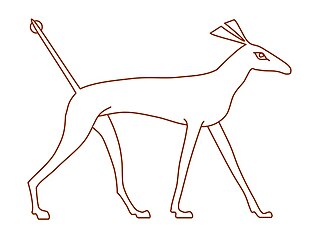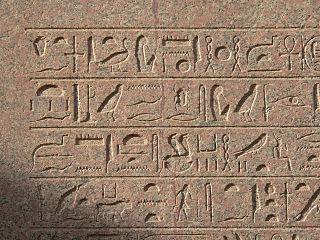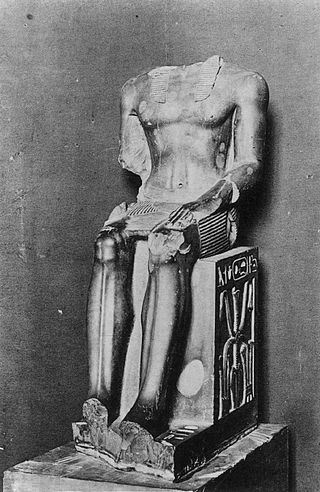
The Min Palette, or El Amrah Palette is an ancient Egyptian cosmetic palette from El-Amrah, Egypt (for the Amratian Period), found in Naqada, tomb B62. It is held in the British Museum, no. 35501. [1]

The Min Palette, or El Amrah Palette is an ancient Egyptian cosmetic palette from El-Amrah, Egypt (for the Amratian Period), found in Naqada, tomb B62. It is held in the British Museum, no. 35501. [1]
The Min Palette is a flat slate palette, unadorned, with no iconographic scenes.
Two topics are displayed on the palette. The Symbol of Min, a compound-type hieroglyph arrangement, is centered at the top of the palette, and comprises 1/4 of the palette's front. The other motifs are opposed-facing bird heads on each top corner; the heads are small, with a thin neck, about a tenth the height of the palette, and the right head is damaged.
A small suspension hole is centered on the palette's top.

In Egyptian hieroglyphs, a cartouche is an oval with a line at one end tangent to it, indicating that the text enclosed is a royal name. The first examples of the cartouche are associated with pharaohs at the end of the Third Dynasty, but the feature did not come into common use until the beginning of the Fourth Dynasty under Pharaoh Sneferu. While the cartouche is usually vertical with a horizontal line, if it makes the name fit better it can be horizontal, with a vertical line at the end. The ancient Egyptian word for cartouche was shenu, and the cartouche was essentially an expanded shen ring. Demotic script reduced the cartouche to a pair of brackets and a vertical line.
Gardiner's Sign List is a list of common Egyptian hieroglyphs compiled by Sir Alan Gardiner. It is considered a standard reference in the study of ancient Egyptian hieroglyphs.
This is a glossary of ancient Egypt artifacts.
The ancient Egyptian Incense burner: arm is a horizontal hieroglyph representing various types of horizontal tools used to offer, and burn incense. In tomb scenes, it is sometimes depicted with a little cup-shaped box attached for keeping incense on the top surface; the person making the offering is occasionally seen holding an incense grain-pellet with lines of incense, or linked grains-in-a-line, which are equivalent to drifting smoke.

The Battlefield Palette may be the earliest battle scene representation of the dozen or more ceremonial or ornamental cosmetic palettes of ancient Egypt. Along with the others in this series of palettes, including the Narmer Palette, it includes some of the first representations of the figures, or glyphs, that became Egyptian hieroglyphs. Most notable on the Battlefield Palette is the standard, and Man-prisoner hieroglyph, probably the forerunner that gave rise to the concept of the Nine bows.

The Hunters Palette or Lion Hunt Palette is a circa 3100 BCE cosmetic palette from the Naqada III period of late prehistoric Egypt. The palette is broken: part is held by the British Museum and part is in the collection of the Louvre.

The Bull Palette is the fragment of an Ancient Egyptian greywacke palette, carved in low relief and used, at least in principle, as a cosmetic palette for the grinding of cosmetics. It is dated to Naqada III, the final two centuries of the fourth millennium BC, immediately preceding the Early Dynastic Period). It is in the collection of the Louvre, inventory no. E11255.

The Egyptian hieroglyph Emblem of the West represents the goddess Imentet, personification of the afterlife. It is composed of a hawk or ostrich feather. The alternate version of the symbol contains the complete figure of the hawk, for Horus, with the feather extending sideways, making it similar to the iat standard, surmounted by individual gods. The feather is associated with the headdress worn by the Libyans.

The fish palettes of predynastic Egypt are one of the common types of cosmetic palettes, or more specifically zoomorphic palettes, which are shaped in the form of the animal portrayed. The fish palettes are mostly ovoid in shape.

The Egyptian hieroglyph representing gold, phonetic value nb, is important due to its use in the Horus-of-Gold name, one of the Fivefold Titulary names of the Egyptian pharaoh.

The Egyptian hieroglyph Emblem of the East is a portrayal of a standard, surmounted by the "Symbol of the East". It represents the Goddess Iabet. Her companion goddess Imentet is represented by the "Emblem of the West". As an ideogram, it represents either iꜣbt "east" or iꜣby "left". The symbol for the "West"/"right" was considered 'good', and thus the East symbol sometimes symbolized the opposite of good, evil. However, as the sun rises in the East, the solar cult often used the symbol.

The Egyptian hieroglyph Townsite-city-region is Gardiner sign listed no. O49 for the intersection of a town's streets. In some Egyptian hieroglyph books it is called a city plan.
The ancient Egyptian Brazier hieroglyph is Gardiner sign listed no. Q7 for the cooking brazier. It is shown from the Old Kingdom in the style of a vertical burning flame upon four feet, but the hieroglyph has the flame hiding the fourth foot. Another Gardiner unlisted form has the four feet, with no flame, and in a plan view.

In ancient Egyptian art, the Set animal, or sha, is the totemic animal of the god Set. Because Set was identified with the Greek monster Typhon, the animal is also commonly known as the Typhonian animal or Typhonic beast.

The ancient Egyptian Two Whips with Shen ring hieroglyph, Gardiner sign listed no. S23 is a portrayal of the Shen ring with two Egyptian flails-(Crook and flail); it is a member of the Gardiner subset for "crowns, dress, staves, etc".

The ancient Egyptian Scribe equipment hieroglyph 𓏞, or its reversed form 𓏟, portrays the equipment of the scribe. Numerous scribes used the hieroglyph in stating their name, either on papyrus documents, but especially on statuary or tomb reliefs.

The Land, irrigated hieroglyph represents "district, nome". It is a determinative in the name of provinces and regions in the noun ḥsp, for "garden", "vegetable garden", and "orchard".

In Egyptian hieroglyphs, the hieroglyph is used for the phonetic value of sma, with meanings of to join together, to unite with.
The ancient Egyptian Papyrus roll-tied and sealed hieroglyph comes in the common horizontal, or a vertical form. It is juxtaposed against an open scroll, the Papyrus roll-open hieroglyph,